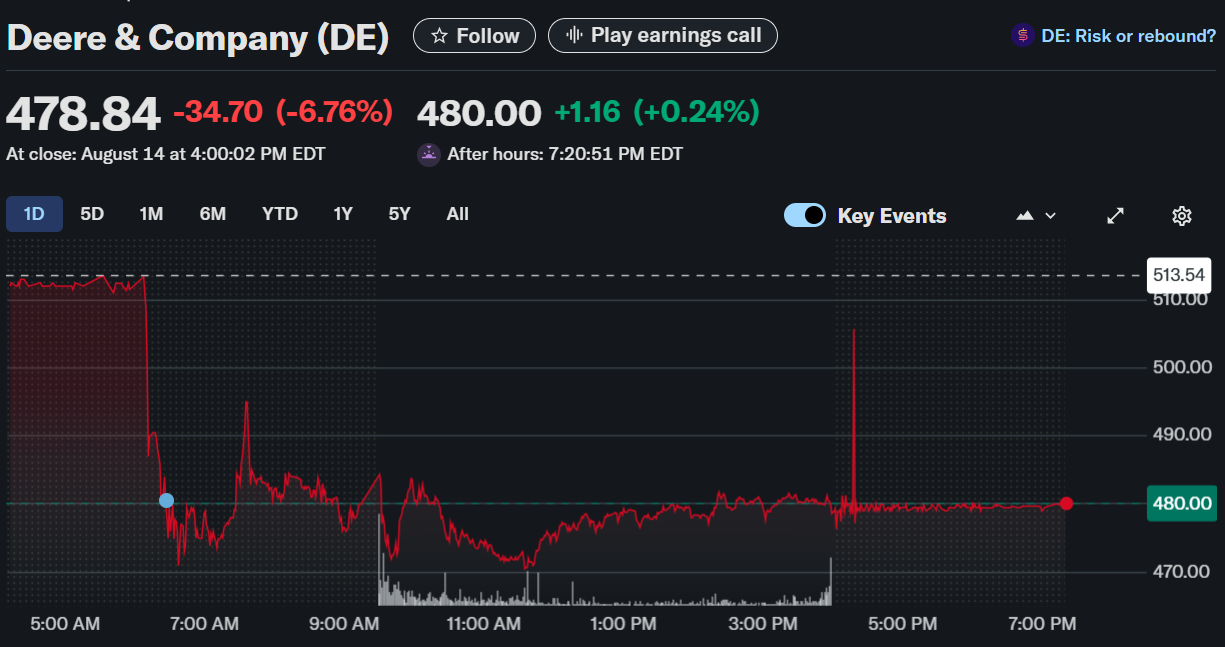Deere (DE) Stock Plummets 6% After Q3 Earnings Disaster: Net Income Crashes 26%, Revenue Down 9%
Deere just handed Wall Street a rusty wrench to the gut—and analysts are scrambling to downgrade their tractors (and price targets).
The Bloodbath Breakdown
Net income? Down 26%. Revenue? Slashed 9%. Stock price? Free-falling 6% before the opening bell. The agricultural giant’s earnings report reads like a horror script for bulls.
What’s Killing the Green Giant?
Supply chain snarls? Commodity price chaos? Or just good ol’ corporate myopia? Deere’s silence on guidance speaks louder than a combine harvester at dawn.
The Silver Lining (If You Squint)
Some optimists whisper ‘cyclical downturn’—because nothing fixes bad earnings like hopium and a Fed pivot fantasy. Meanwhile, short sellers are circling like vultures over a cornfield.
Funny how ‘precision agriculture’ still can’t predict its own profits. Maybe next quarter they’ll accept payment in Bitcoin.
TLDR
- Deere shares tumble 6.76% after Q3 earnings drop 26%, sales slump 9% YoY
- Q3 earnings fall 26% as Deere battles weak demand, high used inventory levels
- Deere’s Q3 profit slides to $1.29B; shares sink but full-year outlook unchanged
- Soft demand, dealer inventory glut hit Deere’s Q3; stock sees sharp 6.76% drop
- Deere posts 32% YTD profit decline yet sticks to 2025 forecast amid market headwinds
Deere & Company shares dropped 6.76% on August 14, closing at $478.84 after an early morning selloff. In after-hours trading, the stock showed a slight recovery, ticking up 0.24% to $480.00. The decline followed a weaker-than-expected earnings report for the third quarter of fiscal 2025.

Deere & Company (DE)
The company reported a 26% drop in net income for the third quarter, down to $1.289 billion or $4.75 per share. In the same quarter last year, Deere posted $1.734 billion in net income or $6.29 per share. The decline highlighted persistent pressure across Core equipment markets.
This marked the second straight quarter of earnings contraction as Deere continues to manage by softening demand and elevating used equipment levels. Though the company maintained its full-year outlook, the earnings dip spurred a sharp market response. Broader macroeconomic uncertainty and changing demand patterns weighed on sentiment.
Third Quarter Sales and Revenue Slide Across Segments
Net sales for the third quarter dropped to $10.357 billion, down from $11.387 billion in the previous year’s third quarter. Total revenue, including financial services, came in at $12.018 billion, representing a 9% year-over-year decline. The company also reported a significant 18% drop in year-to-date revenue to $33.290 billion.
Sales remained weak across the agriculture and turf equipment segments due to ongoing market normalization and excess inventory in dealer channels. This environment forced Deere to align production closely with current retail demand. Management prioritized inventory control to prevent further pricing pressures and avoid channel imbalances.
Retailers have slowed down new equipment purchases, focusing instead on clearing used inventory, which continues to crowd the market. Deere acknowledged this dynamic and adjusted production schedules accordingly throughout the quarter. As a result, operating performance remained disciplined despite declining top-line figures.
Nine-Month Profit Down 32% While Outlook Holds Steady
For the first nine months of fiscal 2025, Deere reported net income of $3.962 billion or $14.57 per share. This was a sharp decrease from $5.855 billion or $21.04 per share for the same period last year. The year-to-date drop represented a 32% decline in profitability amid broader market headwinds.
Deere’s fiscal 2025 net income forecast was between $4.75 billion and $5.25 billion. The company continues to focus on operational discipline, cost controls, and technology integration across product lines. Advanced features like automation and precision tools remain key to long-term growth.
The leadership emphasized ongoing investments in innovative equipment, which aim to increase efficiency for end users. Technologies such as See & Spray and Harvest Settings Automation are gaining traction in the field. Management believes these innovations will support productivity gains despite near-term sales volatility.
Chairman and CEO John May stressed the importance of aligning supply with end-user demand to stabilize market dynamics. He noted the company’s effort to reduce used equipment buildup and maintain healthy dealer inventories. This strategy, he said, creates a more balanced environment for all stakeholders

